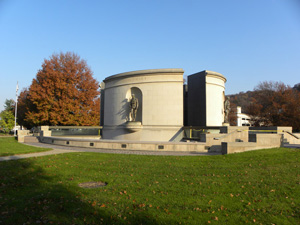

Remember...
Eskridge Allen Waggoner
1910-1943
"No compromise is possible and the victory of the democracies can only be complete with the utter defeat of the war machines of Germany and Japan."
George C. Marshall
 |
Remember...Eskridge Allen Waggoner
|
Eskridge Allen Waggoner was born June 2, 1910, in Alvon, West Virginia. Eskridge's mother was Minnie Boggs Waggoner, and his father was Loyd M. Waggoner. Both of them were born in Greenbrier County, West Virginia, and they married in 1909. Eskridge attended the Hull School up until eighth grade, when he dropped out of school to help his family by working on the farm. Eskridge was the older child of Loyd and Minnie. He had one brother, Ishmael Waggoner, who was five years younger than Eskridge. Eskridge was married to Edna Gray Coulter, who was born in 1922. She passed away in 1940, and Eskridge did not remarry.
Alvon and other towns in Greenbrier County were tight-knit communities, usually with one-room schoolhouses. There are many small towns located in Greenbrier County, with the largest being Lewisburg and White Sulphur Springs. The current population sits at about 35,000 people, up from around 25,000 at the time of Waggoner's birth. The main industry in Greenbrier County was lumber, and the Meadow River Lumber Company was established in the 1920s as Waggoner was growing up. In the coming decades, Greenbrier County's lumber production would become very important, and the population of Greenbrier County grew 37 percent between 1920 and 1930. (Source: Joyce Mott, "Greenbrier County," e-WV: The West Virginia Encyclopedia, 31 May 2013, accessed 16 June 2016, http://www.wvencyclopedia.org/articles/2168.) During World War II, West Virginia had the fifth highest percentage of servicemen in the war, proving that Waggoner was one of many small-town West Virginians with a desire to serve his country during the war. Those who stayed on the home front rationed clothes and food, and opportunities for employment for women increased. Some residents joined the Civil Defense Corps and grew their own food. (Source: West Virginia State Archives, "From Every Mountainside [early 1942 film made by the West Virginia State Road Commission to show West Virginia's part in the war effort]," 31 July 2015, accessed 8 June 2016, https://www.youtube.com.)
Eskridge held many jobs prior to his military days. When he was young, he taught himself how to become a mechanic and handyman. Records show that he also worked as a farmer and as a truck driver during this time period. After the passing of his wife, Edna, Eskridge enlisted in the U.S. Army in the heat of World War II in 1942.
Waggoner met his death in this historic invasion of the Gulf of Salerno. Salerno was chosen as the place to invade as it was the northernmost point at which they could fly from their base in Sicily. This operation was also known as Operation Avalanche, and it began by invading the beaches relatively smoothly. A few days later, Germans and Italians made a very hard counterattack, but it did not matter, as by September 15, 1943, Salerno belonged to the Allies. (Source: "Allies Land at Salerno and Taranto," This Day in History: 1943, accessed 16 June 2016, http://www.history.com/this-day-in-history/allies-land-at-salerno-and-taranto.)
In 2015 the West Virginia Legislature named a bridge in his honor, the "U.S. Army PV2 Eskridge A. Waggoner Memorial Bridge." Locally known as "Mountain Avenue Bridge," it is located on Interstate 64 over Tuckahoe Run and CR 50 in Greenbrier County. Waggoner is buried at the Alvon United Methodist Church Cemetery, located in White Sulphur Springs, West Virginia.
Article prepared by Will Chattin, Hanley Spencer, and Carson Stebbins, George Washington High School Advanced Placement U.S. History

West Virginia Archives and History welcomes any additional information that can be provided about these veterans, including photographs, family names, letters and other relevant personal history.